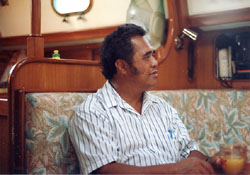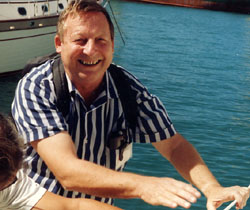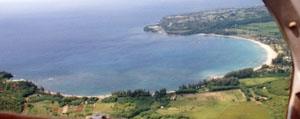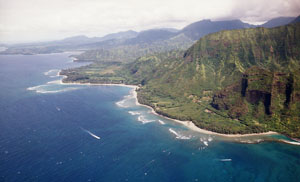Chapter 17 - Southern Cook Islands and Hawaii The Passage to RaroWe watched the weather closely, and decided to leave NZ on April 19, shortly after a low pressure system passed south of us. This gave us good south-westerly winds for the initial tack toward Rarotonga. The first full day we put 152 miles under the keel. On the third day, with continuing rough seas, and before we'd really gotten our sea legs, the head decided to clog up, just like it had on the passage from Mexico to the Marquesas. Once again we had to extract all the hoses and clean out the hardened salt crystals. It took every ounce of stamina to complete the job. The winds increased to 30-35 knots, with gusts to 40, and swung around to the northeast. Now we had waves crashing over the bow. Baba BarAnn would go flying off the top of the even numbered waves, actually getting airborne for about 1.5 seconds. Then, she would crash in the trough with a bone rattling BAM, and get covered up by the odd number waves. Green water would flow over the decks, but since we were healed over quite a bit, the water just continued off the leeward side. This process continued, hour after hour, for two straight days. It was brutal.The Monitor windvane steered flawlessly, and the GPS satellite navigation system told us precisely where we were. We poked a head out of the cabin every now and then to look around, and then quickly ducked back into our safe and dry cabin. It wasn't very comfortable, but we were making good progress. Then I heard some water sloshing at the bow, in the chain locker. With all the water on deck, lots had gotten into the chain pipe and down into the chain locker. This is normally not a problem, since it drains into the bilge . . . except when the drain is plugged. Several times during the night we had to bail water out of the chain locker. In the morning, we hove to in 27 knots, let out our anchor and all 350 feet of chain into the Pacific (about 500 pounds total), and cleaned out the chain locker. Luckily we didn't catch any whales, while trolling with our heavy gear! The electric windlass balked at hauling up all that weight, and in fact tripped the circuit breaker once, due to the heavy load, but we got it all back into the chain locker. Just like catching a big marlin by pulling back, and then reeling in when you rock forward, I reeled in the anchor only when the bow was going down, as we rocked in the heavy seas. Never a dull moment. Candace was having continued problems with seasickness, so after the third day, when her first scopolamine patch was "used up," she put on a second, half patch. That didn't help, and in fact made her much sicker. For almost the entire 14 day passage to Raro, Candace was very sick. We believe that she had a bad reaction to scopolamine. The glands behind her ears, where the patch was stuck, were swollen and sore. The skin where the first patch was placed was quite red. It looked like a Japanese flag with the red circle against her white skin. Perhaps some of the problem was due to cutting the second patch in two, but I think not. One of the enjoyable diversions during the passage was checking into the Kerikeri Radio net each night, on 4445.0 MHz. John, the net controller, is the friendliest, most pleasant person I've ever heard. After we give him a report similar to the report given to the Seafarers' Net, he then gives us our unique weather report. We might be 500 miles from the nearest boat or land, and yet we have a weather forecast which is tailored just to our location. He warns of weather fronts, telling us from where they'll be coming and when. He tells us what the wind conditions will be the next day. If we don't check in for two days in a row, he'll notify the New Zealand authorities to send out a search plane. Fantastic! We also could follow the progress of our friends, most of whom were heading to Tonga or Fiji. For some reason we have a very good radio signal, so we could help Elenoa out by relaying their weaker signal to Kerikeri radio. And it's all for FREE. I believe he charges New Zealanders $20 per year, but for foreign vessels there's no charge.
RarotongaWe averaged 125 miles per day on the 14 day passage to Rarotonga. Marcia Davock, author of the best cruising guide to the Society Islands, met us at the dock shortly after we arrived in Raro. Although she didn't know us, we had seen her before, at the Seattle boat show. Now she works for a tour promotion company. She and her husband Tom put their name on the list at Shilshole for moorage before leaving on a circumnavigation. Just as they arrived back in Seattle seven years later, their name had finally struggled its way up to number one on the list. I've always envied their perfect timing. In hopes of similar good fortune, we had placed our name on the bottom on the Shilshole waiting list just before we left on our trip. The Rarotonga harbor has one of the worst reputations. It's well earned. There is no protection from the North. About once a week a storm from the north would send large swells into the harbor, making it quite uncomfortable and dangerous. We got tucked into a little nook in the north west corner of the small harbor, and had as much protection as anyone, but it was still bad. Nevertheless, we really enjoyed our stay in Raro. We went to the newspaper office and picked up copies of the Cook Island News that told of our "taro route" last August. We were in four different editions . . . front page twice. We rented a 100 cc motor scooter and zipped around the island. Went to several nice restaurants, and a nice beach on the southeast side of the island. Even on a small scooter, you can ride completely around the island of Rarotonga in just a few hours. After striking up a conversation with some Kiwi's, we found out about a duplicate bridge tournament and went over to watch. Teams from Australia, New Zealand, Tahiti, Moorea, and Rarotonga were competing in a week long event. I was asked to sit in for two matches (eight hands each) during a team of four event. With a good partner, "my team" won the first match 34-2 and then lost the second 14-7. It was tons of fun for me. A few days later, Candace and I played. It was her first duplicate tournament. We finished next to last, but had a good time. The local Puka Puka community invited us to dinner in order to thank us for the taro delivery. As before in Puka Puka, there were many formal speeches. We saw Tom Wichman, our main radio contact during the trip, and thoroughly enjoyed our visit. He now works in the Energy Department, primarily setting up solar panel and massive battery systems for the various Cook islands. He proudly showed us his "piggery." It can easily collect pig excrement which then gets converted into methane gas, good for cooking. Tom is one of those rare individuals who has good ideas, and follows up on them. He's helped islands start pearl shell farms. He worked in a hospital and determined that there was a need for embalming services in Rarotonga in case foreign tourists should die here. With no support from the government, he went to New Zealand and learned "the trade" himself. Then he set up the first embalming service on the island. Now he's interested in desalination to provide water for some of the islands. We proudly showed him Baba BarAnn's solar panels and water maker.
Rarotonga is also the home of Arnold, ZK1DB, known throughout the South Pacific for providing weather information to mariners via ham radio. Arnold Gibbons works at the airport and picks up weather bulletins from Fiji, Papeete, and Honolulu. Then, everyday, seven days a week, he reads these weather bulletins over the ham radio on a voluntary basis. I think that's the highlight of his life. Like Tom Wichman, Arnold was very friendly and likable. In Raro we enjoyed meeting Paul and Sue from Elenoa and Mike and Linda from Desert Star. We also met a cruiser from Italy. He was thirtysomething, had sailed from Genoa, and caught the very first fish in his life just a few weeks before. And I thought I was a terrible fisherman. (Careful readers of this log will notice the absence of boring doggerel about all the fish caught and consumed by the author.) With half a dozen sailing boats in Raro's harbor, along with the usual complement of fishing boats and a large tanker or two, we thought the harbor was "full," especially when the northerly swell started rolling in. We heard that more than twenty sailing boats crowd in later in the year. That has to be suicidal. While we were there Desert Star had its cap rails chewed up very badly while heaving up and down against the dock during a storm. That was the tail end of a cyclone that had previously done some damage to boats we knew who were on their way to Tonga.
Penrhyn IslandWe enjoyed Rarotonga and ended up staying a few days more than we had anticipated. After topping off the diesel and water tanks and getting as much fresh produce as we could, we headed off on May 16 for Penrhyn Island, 750 miles to the north. The winds were relatively light, and we ended up motoring a lot more than usual. For the six day passage we motored 28 hours. I erred in judgment by trying to sail on the rhomb line to Penrhyn. When we had winds from the south and west during the first part of the trip, I should have headed east. That would have made the last two days much easier when the strong eastern, and northeastern trade winds filled in. As it was, we had a difficult time getting back to the east once we were blown to the west of the rhomb line. The trip to Raro was a little slower, and more difficult, because we followed the accepted practice of getting our easting in. Now, on the trip to Penrhyn, we were buffeted by head winds when we failed to get our easting in while we could. Damned if you do, and damned if you don't. Approximately 550 people live in Penrhyn. There's a large circular lagoon, about eight miles in diameter, and two villages. After checking in with Customs, we heard that there was an epidemic; flu or dengue fever they didn't know which. Almost everyone in the larger village was sick. The other village was just recovering. Tom Wichman had told us in Raro that six people had recently died from dengue fever in the Cook Islands. We knew some cruisers who got the disease in the Marquesas last year, and we knew it was about the last thing we wanted! With the steady trade winds blowing, we felt fairly safe on the boat from mosquito bites. A contagious flu, on the other hand, could get us from any contact with the locals. What a shame, we could spend only a few minutes on land. We were nervous and could not afford to be sick. A "MediVac" plane took one very sick individual to the hospital in Raro. A boat with many doctors and medical aides was on its way to Penrhyn. We're a bit peeved that the authorities in Raro hadn't warned us in advance. Luckily for us there was another cruising boat at Penrhyn and we enjoyed meeting Foster and Sally from FellowShip. They had just cruised in Alaska and Hawaii - future destinations for us, and we had just been where they were heading. So both couples had good information to share.
Passage to HonoluluAfter one week, Candace had spent perhaps 30 minutes on Penrhyn, and I had spent maybe three hours. It was time to head north to Hawaii. Foster had convinced us that the more difficult beating necessary to fetch Hilo was not worth it. We agreed with his suggestion to head for Honolulu, about 150 miles west of Hilo. On May 28 we checked out with customs on Penrhyn and headed out the coral pass. Ahead of us was a 1,900 mile passage that required crossing the Inter-Tropical Convergence Zone (ITCZ) (a.k.a "doldrums"), and much beating into the wind and waves. The sailing "game plan" was an easy one. Just stay on a starboard tack and head as close to the wind as you can stand. With easterly winds south of the equator, we could head 30 degrees true. As we headed north [charts of the islands] the wind gradually moved northward, causing us to curve to the west. We had hoped to get as far east as 150 degrees west longitude. Unfortunately, the winds swung to the north earlier than expected, and the furthest east we could attain was 153 degrees west, at 6 degrees north latitude. The winds generally came from 030-045 degrees, forcing us to stay close hauled all the way to Honolulu. Never did we see any winds south of 045 after crossing the ITCZ, despite the pilot charts predictions of ENE winds (067 degrees) MOST of the time. From the above you can surmise that our passage to Hawaii was a tough, wet journey. Baba BarAnn would beat into the waves, causing water to crash on the top of the boat every minute, day after day. Often we would fly off a wave, with the bow airborne, and then come smashing down in the trough. BAM! More water crashing on the boat. Envision a 30,000 pound boat flying. With such rough conditions, there's not much you can do except lie in your bunk. We would listen to tapes, and talk to people on the ham radio. But otherwise it was very boring and uncomfortable. Of course the boat was healed over at an acute angle. I have a "lee cloth" to keep me from falling out of bed. Once a huge wave smashed into us, throwing me against the lee cloth so hard that it tore out one of the grommets. The grommets that were affixed to a double fold with four pieces of canvas held, but a single fold, with two pieces of canvas, wasn't strong enough. The passage was not only tough on the crew, but also the boat. Some lines were ruined, the headsail had the Ultra Violet Protection covering just about completely torn off, and the Autohelm electric autopilot stopped working. The latter could have been a big problem. While sailing, the Monitor does all the steering. But when there isn't enough wind to sail, we turn on the motor and rely on the Autohelm to steer. Luckily, the wind held, and we ended up motoring, and thus hand steering, for only four hours on the entire trip. Two exhausted sailors nosed Baba BarAnn into Ala Wai Harbor, near Waikiki, in just under 14 days. We averaged 137 miles per day for 1925 miles.
Hawaii Yacht ClubAfter checking in with customs, immigration, and the health department, we moved over to the Hawaii Yacht Club. They have a tradition of allowing overseas yachts to tie up at their dock for two weeks, for a reasonable fee. For the first time since leaving San Diego, we could plug into electricity and charge the batteries. True luxury! No more running the engine 45-60 minutes per day. We started to suffer culture shock as we ate some great pizza for lunch in a chilly, air conditioned restaurant. Cars everywhere, traffic lights, hoards of people (mainly Japanese tourist), activity galore. Welcome back to the USA. While in Honolulu we repaired a sail and replaced some lines that were damaged in the last passage. We also mailed the electric autopilot to a repair shop in Seattle. When we picked up our mail, first in more than two months, there was a nice check from 48 North, for the article and photos we'd sent them last fall from New Zealand. Our letter to 48 North must have gone by boat, since it didn't arrive in Seattle until March. The May issue of "48" included a full 10 page article, as well as a dozen or so pictures. There also was a check from Sail magazine for the article that Candace wrote on the "Taro Route." Finally, the June issue of Cruising World included some recipes from Candace, and a picture of Baba BarAnn under sail. It was a picture taken by Martin on Orca during the Tonga-Fiji passage, when we passed him under full sail in the middle of the ocean. In Honolulu we met several new cruisers who had sailed over from Mexico, and were reacquainted with some who had left French Polynesia the prior year to spend the winter in Hawaii. Several of these cruisers suggested that we would enjoy sailing back, upwind, to Maui and Lanai, but we were still tired from the last passage and, frankly, we were kind of "sailed-out." We elected to sail downwind, over to Hanalei Bay on the north end of Kauai, after a short stay at Pokie Bay on the west side of Oahu.
Hanalei Bay
Puff the Magic Dragon sure knows how to pick 'em. Hanalei is one of most beautiful anchorages in the Pacific, and it's on the hands-down most beautiful island in the Pacific. Forget all of French Polynesia or anywhere else that we'd been. Kauai is the most beautiful and, when we were there, had the best weather. Never too hot with temperatures 75-80, virtually no bugs, very little rain, and what there was only came at night, just like in Camelot. Steep mountains, awesome Waimea Canyon, white sandy beaches, and flowering trees everywhere. A mile offshore I could smell the flowers. Kauai was also the cleanest island we'd been to. The streets and beaches were extremely trash-free. As an added bonus, several large turtles, with shells up to two feet in diameter, swim around the bay each morning.
We rented a car for several days to see Waimea Canyon and visit the rest of the island. A local tourist newspaper mentioned a bridge tournament in Lihue, so we checked into a hotel for the night and then went over to play some bridge. One of the players gave us a free certificate for a night's lodging at the fancy Sheraton in Poipu. We also heard about another duplicate game on Saturday nights in Princeville, just three miles from Hanalei. So the next night we were back playing bridge again. We were invited to two more bridge games, as well as dinner. We were spending more time on shore than on the boat. Before "using" our free night at the Sheraton, we splurged on a 60 minute sightseeing helicopter trip around Kauai. Awesome! You might guess that Candace and I had a fun time in Kauai. We could easily enjoy returning to Kauai for a long vacation. We consistently heard from the other cruisers in Hanalei Bay that this was by far the best anchorage in the Hawaiian Islands. That was nice to hear since we missed seeing most of Hawaii. Now it was time to prepare for the long trip back to the Seattle. The autopilot appears to be fixed and everything is in working order. Ahead of us lies a 2,600 mile passage, over and around the Pacific high pressure system. Sure hope our heater works!
|



